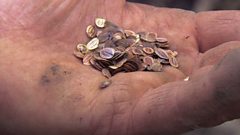
Episode 8
Gardening magazine. Carol Klein visits Keith Wiley's garden in Devon, which celebrates the dog's-tooth violet. Rachel de Thame is at the Royal Botanic Garden in Edinburgh.
Carol Klein visits eminent plantsman Keith Wiley at his garden in Devon, which celebrates the exquisite dog's-tooth violet. Keith is passionate about these unsung woodland plants.
Rachel de Thame visits the Royal Botanic Garden in Edinburgh to take a look behind the scenes at their world-renowned collection of alpines and find out what it takes to keep their fantastic display at the peak of perfection.
And at Longmeadow, Monty Don cracks on with some timely tasks and makes a start on planting up a yew hedge.
Last on
Clips
-
![]()
Sowing parsnips with radishes
Duration: 01:45
-
![]()
Carol Klein discusses erythroniums with Keith Wiley
Duration: 03:34
Monty’s alpine trough

Alpines, with their often exquisite and delicate flowers, are found at high altitude above the treeline in some of the most extreme and exposed places in the world. However, you don’t have to live on a mountain to enjoy these little gems; a backyard, balcony or windowsill of any size will make a great home for a selection of alpine plants.Β
Alpine plants are very cheap to buy which means you can experiment freely with your planting ideas and change your display as and when you feel like it. Just remember that some alpines will become dormant so take care not to dig up any sleeping plants!
Monty filled a stone alpine trough in a sunny position with a 50:50 mix of peat-free, multi-purpose compost and grit. He chose plants from sunny, rocky mountains and scree slopes, a full list of which is given below:Β
- Androsace sarmentosa (Rock jasmine)
- Androsace studiosorum 'Doksa' (Rock jasmine)
- Armeria juniperifolia 'Brookside' (Juniper-leaved thrift)
- Erodium x kolbianum 'Natasha'
- Gypsophila cerastioides (Mouse-ear gypsophila)
- Orostachys spinosa (Spiny pennywort)
- Saxifraga cotyledon (Pyramidal saxifrage)
- Sedum spathulifolium 'Cape Blanco' (Spoon-leaved stonecrop)
- Thymus 'Bressingham' (Thyme)Β
(www.alpinegardensociety.net)
Alpine garden featured

Royal Botanic Garden Edinburgh
20a Inverleith Row
Edinburgh
EH3 5LR
Tel. 0131 552 7171
Rachel visited the extraordinary alpine collection at the Royal Botanic Garden Edinburgh and met Alpine Supervisor, John Mitchell. John has travelled the world to observe plants in the wild and collect material, including rarities such as Dionysia afghanica from the limestone cliffs in Northwestern Afghanistan and Hepatica falconeri from Kurdistan.
The alpine displays are at their best in the spring but have something interesting to see each season.Β If you fancy a visit, check out the link below.
(www.rbge.org.uk)
Planting hedges and replacing box
Box blight has taken a hold at Longmeadow and some of Monty’s hedging is really suffering. In response, he is removing the worst affected plants and replacing them with yew.
Container-grown plants are available all year round and can be planted at any time. Just make sure to water the plants regularly and be especially careful during dry spells and hot weather to ensure they have enough moisture. Root-balled or bare-root plants are available from October to April. They are cheaper to buy but require planting as quickly as possible after purchasing so they are not out of the ground for too long. Shop around and then decide what’s best for you in terms of price and time of planting.Β
Monty chose to use yew but there are other plants that would work like box as a closely clipped hedge:
- Ilex crenata (box-leaved holly)
- Lonicera nitida (Wilson's honeysuckle)
- Pittosporum tobira 'Nanum' (Japanese pittosporum)
- Sarcococca ruscifolia
(apps.rhs.org.uk)
Erythronium garden featured
Wildside Nursery
Green Lane
Buckland Monachoram
nr Yelverton
Devon
PL20 7NP
In 2014, Wildside willl be open for the first five days of June, July and August. The erythroniums will be over by then, but there will be plenty of other exciting plants to see. Please make sure you check their website before you visit.
(www.wileyatwildside.com)
Jobs for the weekend: Pinch out sweet peas
Sweet pea plants (especially those that have become tall and leggy) can be pinched out now. Simply nip out the tip of each plant using your fingers or a small pair of scissors, just above a set of leaves. In doing so, you’ll encourage the plant to develop more side-shoots and produce more flowers for you to cut and enjoy.Β
(apps.rhs.org.uk)
Jobs for the weekend: Support herbaceous perennials
Herbaceous perennials and tall annuals can be damaged by the weather as they grow. Some also become top heavy and may flop onto other garden plants as they mature over the summer. Getting in early and providing a backbone or frame for these plants will pay dividends later. Use your favourite plant support (bamboo canes, metal stakes, pea sticks, whatever you fancy) and create a structure which is capable of supporting growth without confining the plant.
(apps.rhs.org.uk)
Jobs for the weekend: Sow courgettes
For early crops, sow courgette seed indoors. Plant one or two seeds 13mm (0.5in) deep in a small pot, water in and place somewhere warm (minimum temperature 13°C). Once germinated, make sure the emerging seedlings have plenty of light. If you’ve sown two per pot, weed out the weakest and, once the remaining seedling is well-rooted (check for signs of root coming out of the bottom of the pot), harden off and plant out once all threat of frost has gone.
(www.rhs.org.uk)
Credits
| Role | Contributor |
|---|---|
| Presenter | Monty Don |
| Presenter | Carol Klein |
| Presenter | Rachel de Thame |
| Series Producer | Christina Nutter |
| Series Editor | Liz Rumbold |
Broadcasts
- Fri 25 Apr 2014 20:30Βι¶ΉΤΌΕΔ Two except Wales
- Sat 26 Apr 2014 18:30Βι¶ΉΤΌΕΔ Two Wales
- Sun 27 Apr 2014 09:00
- Thu 8 May 2014 10:05
Featured in...
![]()
Gardeners' World
Gardening show packed with ideas and timely reminders to get the most out of your garden



